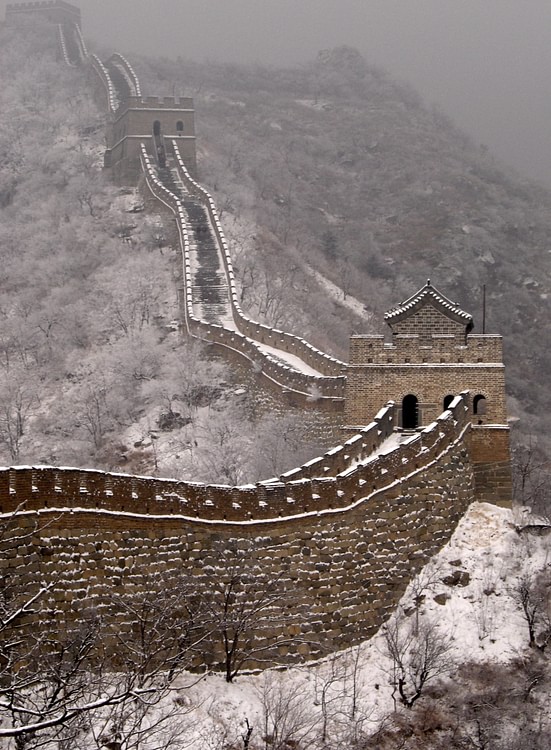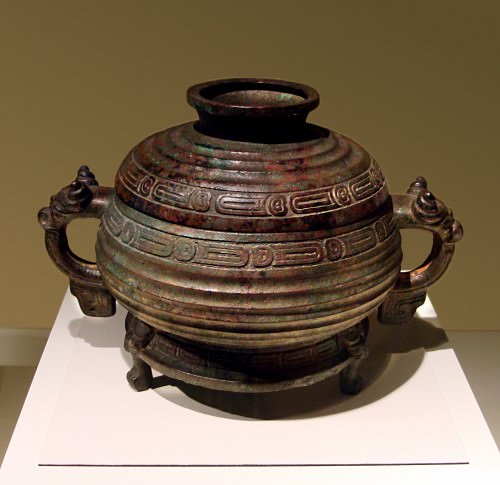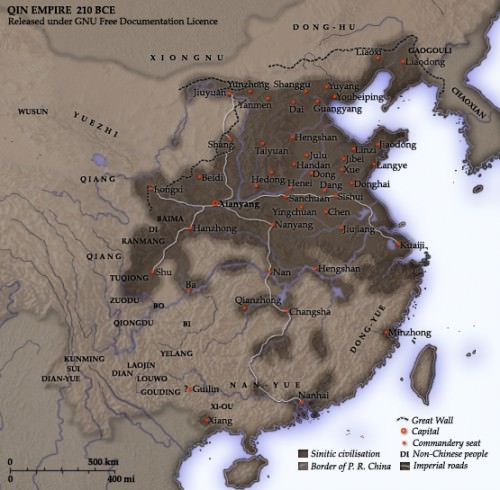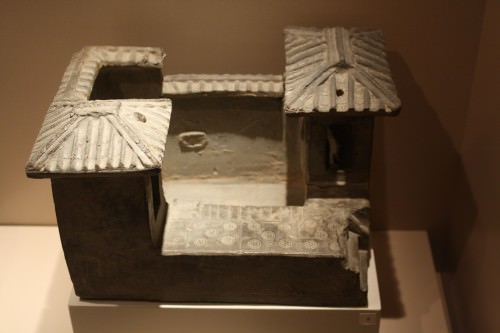Ancient China produced what has become the oldest, still extant, culture in the world. The name `China’ comes from the Sanskrit Cina (derived from the name of the Chinese Qin Dynasty, pronounced `Chin’) which was translated as `Cin’ by the Persians and seems to have become popularized through trade along the Silk Road from China to the rest of the world. The Romans and the Greeks knew the country as `Seres’, “the land where silk comes from”. The name `China’ does not appear in print in the west until 1516 CE in Barbosa’s journals narrating his travels in the east (though the Europeans had long known of China through trade via the Silk Road). Marco Polo, the famous explorer who familiarized China to Europein the 13th century CE, referred to the land as `Cathay’. In Mandarin Chinese, the country is known as `Zhongguo” meaning `central state’ or `middle empire’.
PRE-HISTORY
Well before the advent of recognizable civilization in the region, the land was occupied by hominids. Peking Man, a skull fossil discovered in 1927 CE near Beijing, lived in the area between 700,000 to 200,000 years ago and Yuanmou Man, whose remains were found in Yuanmou in 1965 CE, inhabited the land 1.7 million years ago. Evidence uncovered with these finds shows that these early inhabitants knew how to fashion stone tools and use fire. While it is commonly accepted that human beings originated in Africa and then migrated to other points around the globe, China’s paleoanthropologists “support the theory of `regional evolution’ of the origin of man” (China.org) which claims an independent basis for the birth of mankind. “The Shu Ape, a primate weighing only 100 to 150 grams and being similar to a mouse in size, lived [in China] in the Middle Eocene Epoch 4.5 to 4 million years ago. Its discovery posed a great challenge to the theory of African origin of the human race” (China.org). This challenge is considered plausible due to genetic links between the Shu Ape fossil and both advanced and lower primates, standing, then, as a `missing link’ in the evolutionary process. However one interprets this data (the Chinese conclusions have been disputed by the international community), the solid evidence provided by other finds substantiates a very ancient lineage of hominids and human beings in China and a high level of sophistication in early culture. One example of this is Banpo Village, near Xi’an, discovered in 1953 CE. Banpo is a Neolithic village which was inhabited between 4500 and 3750 BCE and comprises 45 houses with floors sunk into the ground for greater stability. A trench encircling the village provided both protection from attack and drainage while man-made caves dug underground were used to store food. The design of the village, and the artifacts discovered there (such as pottery and tools), argue for a very advanced culture at the time it was constructed.
It has generally been accepted that the Chinese `Cradle of Civilization’ is the Yellow River Valley which gave rise to villages sometime around 5000 BCE. While this has been disputed, and arguments have been made for a more wide-spread development of communities, there is no doubt that the Henan province, in the Yellow River Valley, was the site of many early villages and farming communities. In 2001 CE, archaeologists uncovered two skeletons “buried in a collapsed house, which was covered with a thick layer of silt deposits from the Yellow River. In the layer of deposits, archaeologists found more than 20 skeletons, an altar, a square, pottery, and stone and jade utensils” (Chinapage.org). This site was only one of many prehistoric villages in the area.
THE FIRST DYNASTIES
From these small villages and farming communities grew centralized government; the first of which was the prehistoric Xia Dynasty(c. 2070-1600 BCE). The Xia Dynasty was considered, for many years, more myth than fact until excavations in the 1960’s and 1970’s CE uncovered sites which argued strongly for its existence. Bronze works and tombs clearly point to an evolutionary period of development between disparate Stone Agevillages and a recognizable cohesive civilization. The dynasty was founded by Yu the Great who worked relentlessly for thirteen years to control the flooding of the Yellow River which routinely destroyed the farmer’s crops. He was so focused on his work that it was said he did not return home once in all those years, even though he seems to have passed by his house on at least three occasions, and this dedication inspired others to follow him. After he had controlled the flooding, Yu conquered the Sanmiao tribes and was named successor (by the then-ruler, Shun), reigning until his death. Yu established the hereditary system of succession and, so, the concept of dynasty which has become most familiar. The ruling class and the elite lived in urban clusters while the peasant population, which supported their lifestyle, remained largely agrarian, living in rural areas. Yu’s son, Qi, ruled after him and power remained in the hands of the family until the last Xia ruler, Jie, was overthrown by Tang who established the Shang Dynasty (1600-1046 BCE).
Tang was from the kingdom of Shang. The dates popularly assigned to him (1675-1646 BCE) do not in any way correspond to the known events in which he took part and must be considered erroneous. What is known is that he was the ruler, or at least a very important personage, in the kingdom of Shang who, around 1600 BCE, led a revolt against Jie and defeated his forces at the Battle of Mingtiao. The extravagance of the Xia court, and the resultant burden on the populace, is thought to have led to this uprising. Tang then assumed leadership of the land, lowered taxes, suspended the grandiose building projects begun by Jie (which were draining the kingdoms of resources) and ruled with such wisdom and efficiency that art and culture were allowed to flourish. Writing developed under the Shang Dynasty as well as bronze metallurgy, architecture, and religion.
Prior to the Shang, the people worshipped many gods with one supreme god, Shangti, as head of the pantheon (the same pattern found in other cultures). Shangti was considered `the great ancestor’ who presided over victory in war, agriculture, the weather, and good government. Because he was so remote and so busy, however, the people seem to have required more immediate intercessors for their needs and so the practice of ancestor worship began. When someone died, it was thought, they attained divine powers and could be called upon for assistance in times of need (similar to the Roman belief in the Parentes). This practice led to highly sophisticated rituals dedicated to appeasing the spirits of the ancestors which eventually included ornate burials in grand tombs filled with all one would need to enjoy a comfortable afterlife. The king, in addition to his secular duties, served as chief officiate and mediator between the living and the dead and his rule was considered ordained by divine law. Although the famous Mandate of Heaven was developed by the later Zhou Dynasty, the idea of linking a just ruler with divine will has its roots in the beliefs fostered by the Shang.
THE ZHOU DYNASTY
Around the year 1046 BCE, King Wu, of the province of Zhou, rebelled against King Zhou of Shang and defeated his forces at the Battle of Muye, establishing the Zhou Dynasty (c. 1046- 256 BCE). 1046-771 BCE marks the Western Zhou Period while 771-226 BCE marks the Eastern Zhou Period. The Mandate of Heaven was invoked by the Duke of Zhou, King Wu’s younger brother, to legitimize the revolt as he felt the Shang were no longer acting in the interests of the people. The Mandate of Heaven was thus defined as the gods’ blessing on a just ruler and rule by divine mandate. When the government no longer served the will of the gods, that government would be overthrown. Further, it was stipulated that there could be only one legitimate ruler of China and that his rule should be legitimized by his proper conduct as a steward of the lands entrusted him by heaven. Rule could be passed from father to son but only if the child possessed the necessary virtue to rule. This mandate would later be often manipulated by various rulers entrusting succession to unworthy progeny.
Under the Zhou, culture flourished and civilization spread. Writing was codified and iron metallurgy became increasingly sophisticated. The greatest and best known Chinese philosophers and poets, Confucius, Mencius, Mo Ti (Mot Zu), Lao-Tzu, Tao Chien, and the military strategist Sun-Tzu (if he existed as depicted), all come from the Zhou period in China and the time of the Hundred Schools of Thought. The chariot, which was introduced to the land under the Shang, became more fully developed by the Zhou. It should be noted that these periods and dynasties did not begin nor end as neatly as they seem to in history books and the Zhou Dynasty shared many qualities with the Shang (including language and religion). While historians find it necessary, for clarity’s sake, to break events into periods, the Zhou Dynasty remained extant through the following recognized periods known as The Spring and Autumn Period and The Warring States Period.
THE SPRING & AUTUMN PERIOD & THE WARRING STATES
During the Spring and Autumn Period (772-476 BCE and so called from the Spring and Autumn Annals, the official chronicle of the state at the time and an early source mentioning General Sun-Tzu), the Zhou government became decentralized in their move to the new capital at Luoyang, marking the end of the `Western Zhou’ period and the beginning of `Eastern Zhou’. This is the period most noted for advances in philosophy, poetry, and the arts and saw the rise of Confucian, Taoist, and Mohist thought. At the same time, however, the different states were breaking away from central rule by Luoyang and proclaiming themselves sovereign. This, then, led to the so-called Warring States Period (476-221 BCE) in which seven states fought with each other for control. The seven states were Chu, Han, Qi, Qin, Wei, Yan, and Zhao all of whom considered themselves sovereign but none of whom felt confident in claiming the Mandate of Heaven still held by the Zhou of Luoyang. All seven of the states used the same tactics and observed the same rules of conduct in battle and so none could gain the advantage over the others. This situation was exploited by the pacifist philosopher Mo Ti, a skilled engineer, who made it his mission to provide each state with equal knowledge of fortifications and siege ladders in hopes of neutralizing any one state’s advantage and so ending the war. His efforts were unsuccessful however and, between 262 and 260 BCE, the state of Qin gained supremacy over Zhao, finally defeating them at The Battle of Changping.
A Qin statesman by the name of Shang Yang (died 338 BCE), a great believer in efficiency and law, had re-cast the Qin understanding of warfare to focus on victory at any cost. Whether Sun-Tzu or Shang Yang is to be credited with reformation of military protocol and strategy in China depends on one's acceptance of Sun-Tzu's historicity. Whether Sun-Tzu existed as people claim, however, it is very probable that Shang Yang was acquainted with the famous work, The Art of War, which bears Sun-Tzu's name as author. Prior to these reforms, warfare was considered a nobleman’s game of skill with very set rules dictated by courtesy and the perceived will of heaven. One did not attack the weak or the unprepared and one was expected to delay engagement until an opponent had mobilized and formed ranks on the field. Shang advocated total war in pursuit of victory and counselled taking the enemies’ forces by whatever means lay at hand. Shang’s principles were known in Qin, and made use of at Changping (where over 450,000 captured Zhao soldiers were executed after the battle) giving the Qin the advantage they had been waiting for. Still, they did not make further effective use of these tactics until the rise of Ying Zheng, King of Qin. Utilizing Shang’s directives, and with an army of considerable size utilizing chariots and iron weapons, Ying Zheng emerged from the Warring States conflict supreme in 221 BCE, subduing and unifying the other six states under his rule and proclaiming himself Shi Huangdi -`First Emperor’ - of China.
THE QIN DYNASTY
Shi Huangdi thus established the Qin Dynasty (221-206 BCE) which is also known as the Imperial Era in China. He ordered the destruction of the walled fortifications which had separated the different states and commissioned the building of a great wall along the northern border of his kingdom. Though little remains today of Shi Huangdi’s original wall, The Great Wall of China was begun under his rule.
It stretched for over 5,000 kilometres (3,000 miles) across hill and plain, from the boundaries of Korea in the east to the troublesome Ordos Desert in the west. It was an enormous logistical undertaking, though for much of its course it incorporated lengths of earlier walls built by the separate Chinese kingdoms to defend their northern frontiers in the fourth and third centuries. (Scarre and Fagan, 382).
Shi Huangdi also strengthened the infrastructure through road building which helped to increase trade through ease of travel.
Five trunk roads led from the imperial capital at Xianyang, each provided with police forces and posting stations. Most of these roads were of rammed-earth construction and were 15 metres (50 feet) wide. The longest ran southwest over 7,500 kilometres (4,500 miles) to the frontier region of Yunnan. So precipitous was the countryside that sections of the road had to be built out from vertical cliff faces on projecting timber galleries. (Scarre and Fagan, 382).
Shi Huangdi also expanded the boundaries of his empire, built the Grand Canal in the south, redistributed land and, initially, was a fair and just ruler.
While he made great strides in building projects and military campaigns, his rule became increasingly characterized by a heavy hand in domestic policy. Claiming the Mandate from Heaven, he suppressed all philosophies save the Legalism which had been developed by Shang Yang and, heeding the counsel of his chief advisor, Li Siu, he ordered the destruction of any history or philosophy books which did not correspond to Legalism, his family line, the state of Qin, or himself.
Since books were then written on strips of bamboo fastened with swivel pins, and a volume might be of some weight, the scholars who sought to evade the order were put to many difficulties. A number of them were detected; tradition says that many of them were sent to labor on the Great Wall, and that four hundred and sixty were put to death. Nevertheless some of the literati memorized the complete works of Confucius and passed them on by word of mouth to equal memories. (Durant, 697).
This act, along with Shi Huangdi’s suppression of general freedoms, including freedom of speech, made him progressively more unpopular.
The ancestor worship of the past, and the land of the dead, began to interest the emperor more than his realm of the living and Shi Huangti became increasingly engrossed in what this other world consisted of and how he might avoid traveling there. He seems to have developed an obsession with death, became increasingly paranoid regarding his personal safety, and ardently sought after immortality. His desire to provide for himself an afterlife commensurate with his present one led him to commission a palace built for his tomb and an army of over 8,000 terracotta warriors created to serve him in eternity. This ceramic army, buried with him, also included terracotta chariots, cavalry, a commander in chief, and assorted birds and animals. He is said to have died while on a quest for an elixir of immortality and Li Siu, hoping to gain control of the government, kept his death a secret until he could alter his will to name his pliable son, Hu-Hai, as heir. This plan proved untenable, however, as the young prince showed himself to be quite unstable, executing many, and initiating a widespread rebellion in the land. Shortly after Shi Huangdi’ s death, the Qin Dynasty quickly collapsed through the intrigue and ineptitude of people like Hu-Hai, Li Siu, and another advisor, Zhao Gao, and the Han Dynasty began with the accession of Liu-Bang.
THE CHU-HAN CONTENTION
With the fall of the Qin Dynasty, China was plunged into chaos. Two generals emerged among the forces which rebelled against the Qin, Prince Liu-Bang of Hanzhong and King Xiang-Yu of the state of Chu, who fought for control of the government. Xiang-Yu, who had proven himself the most formidable opponent of the Qin, awarded Liu-Bang the title of `King of the Han’ in recognition of Liu-Bang’s decisive defeat of the Qin forces in the final battle. The two former allies quickly became antagonists, however, in the power struggle known as the Chu-Han contention until Xiang-Yu negotiated the Treaty of Hong Canal and brought a temporary peace. Xiang-Yu suggested dividing China under the rule of the Chu in the east and the Han in the west but Liu-Bang wanted a united China under Han rule and, breaking the treaty, resumed hostilities. At the Battle of Gaixia in 202 BCE, Liu-Bang’s great general, Han-Xin, trapped and defeated the forces of Chu under Xiang-Yu and Liu-Bang was proclaimed emperor (known to posterity as Emperor Gaozu of Han). Xiang-Yu committed suicide but his family was allowed to live and even serve in government positions. Liu-Bang treated all of his former adversaries with respect and united the land under his rule. He pushed back the nomadic Xiongnu tribes, who had been making incursions into China, and made peace with the other states which had risen in rebellion against the failing Qin Dynasty. The Han Dynasty (which derives its name from Liu-Bang’s home in Hanzhong province) would rule China, with a brief interruption, for the next 400 years, from 202 BCE to 220 CE.




